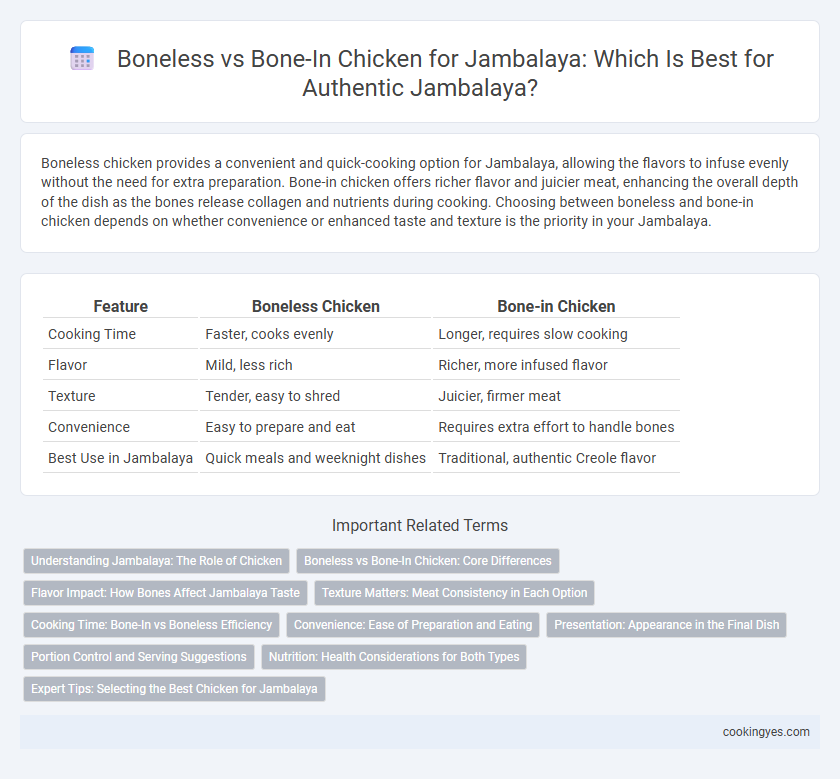Boneless chicken provides a convenient and quick-cooking option for Jambalaya, allowing the flavors to infuse evenly without the need for extra preparation. Bone-in chicken offers richer flavor and juicier meat, enhancing the overall depth of the dish as the bones release collagen and nutrients during cooking. Choosing between boneless and bone-in chicken depends on whether convenience or enhanced taste and texture is the priority in your Jambalaya.
Table of Comparison
| Feature | Boneless Chicken | Bone-in Chicken |
|---|---|---|
| Cooking Time | Faster, cooks evenly | Longer, requires slow cooking |
| Flavor | Mild, less rich | Richer, more infused flavor |
| Texture | Tender, easy to shred | Juicier, firmer meat |
| Convenience | Easy to prepare and eat | Requires extra effort to handle bones |
| Best Use in Jambalaya | Quick meals and weeknight dishes | Traditional, authentic Creole flavor |
Understanding Jambalaya: The Role of Chicken
Boneless chicken is preferred in jambalaya for its ease of cooking and ability to evenly absorb the dish's spices, resulting in a tender, flavorful texture that blends seamlessly with rice and vegetables. Bone-in chicken offers a richer, deeper flavor profile due to the marrow and connective tissues releasing natural juices during the slow simmering process, enhancing the overall complexity of the jambalaya. Choosing between boneless and bone-in chicken affects cooking time, texture, and flavor intensity, making it a crucial decision for authentic jambalaya preparation.
Boneless vs Bone-In Chicken: Core Differences
Boneless chicken in jambalaya provides quicker cooking times and easier shredding, enhancing the dish's texture and uniformity. Bone-in chicken imparts deeper flavor through marrow and slow cooking, enriching the jambalaya's savory profile. Choosing between boneless and bone-in impacts cooking method, flavor intensity, and overall dish authenticity.
Flavor Impact: How Bones Affect Jambalaya Taste
Bone-in chicken enhances jambalaya flavor by releasing rich marrow and collagen during cooking, which deepens the dish's savory complexity and richness. The slow simmering process extracts gelatin from the bones, creating a more robust, velvety texture that coats the rice and spices thoroughly. Boneless chicken absorbs spices more evenly but lacks the depth and umami that bone-in pieces contribute to traditional jambalaya recipes.
Texture Matters: Meat Consistency in Each Option
Boneless chicken in jambalaya offers a uniform, tender texture that easily absorbs the dish's bold spices and sauces, creating a consistent mouthfeel throughout each bite. Bone-in chicken provides a richer, more complex flavor due to the marrow and connective tissues, resulting in a slightly firmer texture that enhances the overall robustness of the jambalaya. Choosing between boneless and bone-in chicken ultimately impacts the meat's consistency, with boneless delivering smoothness and bone-in offering depth and variety in each serving.
Cooking Time: Bone-In vs Boneless Efficiency
Bone-in chicken typically requires 30 to 40 minutes to cook thoroughly in jambalaya, ensuring rich flavor infusion and tender meat, while boneless chicken cooks faster, usually in 15 to 20 minutes, offering convenience and quicker meal preparation. Choosing bone-in pieces enhances depth of taste due to marrow and connective tissues releasing flavor during the extended cooking time, which is ideal for traditional jambalaya recipes. Boneless chicken provides efficiency for busy cooks, reducing overall cooking duration without sacrificing protein content, making it suitable for faster weeknight jambalaya dishes.
Convenience: Ease of Preparation and Eating
Boneless chicken offers greater convenience for jambalaya due to faster cooking times and easier consumption, eliminating the need to navigate around bones. Bone-in chicken imparts richer flavor during cooking but requires extra effort to debone, potentially slowing down meal prep and eating. Prioritizing boneless chicken streamlines both preparation and eating, enhancing overall dining efficiency for jambalaya.
Presentation: Appearance in the Final Dish
Boneless chicken in jambalaya offers a cleaner presentation, allowing for uniform, bite-sized pieces that blend seamlessly with rice and vegetables. Bone-in chicken provides a rustic, hearty appearance, often highlighting individual drumsticks or thighs that add visual variety and authenticity. The choice impacts the dish's aesthetic balance between refined elegance and traditional comfort.
Portion Control and Serving Suggestions
Boneless chicken in jambalaya offers precise portion control, ensuring even cooking and easier serving, while bone-in chicken imparts richer flavor and moisture during simmering. For serving suggestions, boneless cuts work well for quick, casual meals or when shredding chicken for uniform texture, whereas bone-in pieces enhance presentation and deepen the dish's complexity in traditional recipes. Balancing meat type with desired cooking style and serving size optimizes jambalaya's taste and visual appeal.
Nutrition: Health Considerations for Both Types
Boneless chicken used in jambalaya typically contains less saturated fat and fewer calories, making it a healthier option for those monitoring fat intake and aiming for lean protein sources. Bone-in chicken provides added nutrients such as calcium and collagen, which are beneficial for joint health and skin elasticity but can be higher in fat content depending on the cut. Choosing between boneless and bone-in chicken for jambalaya depends on balancing preferences for convenience, nutrient density, and dietary goals.
Expert Tips: Selecting the Best Chicken for Jambalaya
Using bone-in chicken for jambalaya enhances the dish with richer flavor and deeper chicken broth, as bones release gelatin and nutrients during cooking. Expert tips recommend choosing bone-in, skin-on thighs for tender, juicy meat that withstands long simmering without drying out. Boneless chicken cooks faster but risks dryness; if preferred, marinate it well and add it later in the cooking process to maintain moisture and flavor.
Boneless vs Bone-in for Jambalaya chicken Infographic

 cookingyes.com
cookingyes.com